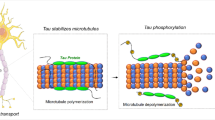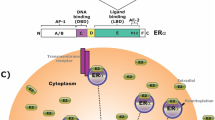Abstract
Postmenopausal estrogen replacement therapy (ERT) is associated with numerous overall health benefits, including reduced risk of osteoporosis and a decrease in mortality (1). Of particular interest to neurodegenerative disease, ERT correlates with a decreased incidence of Alzheimer’s disease (AD) (2,3), reducing the onset of the disease by as much as 10 years in one study (3). Further, several small clinical studies support a role for estrogen therapy in improving cognitive function in AD patients (4–6). Epidemiological studies have also demonstrated a beneficial effect of ERT in reducing the mortality and morbidity associated with myocardial infarction and stroke in postmenopausal women (7–10).
Access this chapter
Tax calculation will be finalised at checkout
Purchases are for personal use only
Preview
Unable to display preview. Download preview PDF.
Similar content being viewed by others
References
Paganini-Hill A. The risks and benefits of estrogen replacement therapy: leisure world. Int J Fertil 1995;40S:54–62.
Paganini-Hill A, Henderson VW. Estrogen deficiency and risk of Alzheimer’s disease in women. Am J Epidemiol 1994;140:256–61.
Tang M, Jacobs D, Stern Y, Marder K, Schofield P, Gurland B, et al. Effect of oestrogen during menopause on risk and age at onset ofAlzheimer’s disease. Lancet 1996;348:429–32.
Fillit H, Weinreb H, Cholst I, McEwen B, Amador R, Zabriskie J. Observations in a preliminary open trial of estradiol therapy for senile dementia-Alzheimer’s type. Psychoneuroendocrinology 1986;11:337–45.
Honjo H, Ogino Y, Naitoh K, Urabe M, Yasude J. In vivo effects by estrone sulfate on the central nervous system-senile dementia (Alzheimer’s type). J Steroid Biochem 1989;34:521–25.
Ohkura T, Isse K, Akazawa K, Hamamoto M, Yaoi Y, Hagino N. Low-dose estrogen replacement therapy for Alzheimer disease in women. Menopause: J N Am Menopause Soc 1994;3:125–30.
Lafferty FW, Fiske, ME. Postmenopausal estrogen replacement: a long-term cohort study. Am J Med 1994;97:66–77.
Lobo RA. Cardiovascular implications of estrogen replacement therapy. Obstet Gynecol 1990;75:18s-25s.
Grodstein F, Stampfer MJ, Manson JE, Colditz GA, Willett WC, Rosner B, et al. Postmenopausal estrogen and progestin use and the risk of cardiovascular disease. N Engl J Med 1996;335:453–61.
Gaspard UJ. Evaluation of the cardiovascular impact of hormonal replacement therapy in menopausal women. J Gynecol Obstet Biol Reprod (Paris) 1996;25: 671–76.
Bishop J, Simpkins JW. Estradiol treatment increases viability of glioma and neuroblastoma cells in vitro. Mol Cell Neurosci 1994;5:303–8.
Behl C, Widmann M, Trapp T, Holspoer F. 173-estradiol protects neurons from oxidative stress-induced cell death in vitro. Biochem Biophys Res Comm 1995;216: 473–82.
Goodman Y, Bruce AJ, Cheng B, Mattson MP. Estrogen attenuates and corticosterone exacerbates excitoxicity, oxidative injury, and amyloid 3-peptide toxicity in hippocampal neurons. J Neurochem 1996;66:1836–44.
Green PS, Gridley KE, Simpkins JW. Estradiol protects against β-amyloid (25–35)induced toxicity in SK-N-SH cells. Neurosci Lett 1996;218:165–68.
Behl C, Skutella T, Lezoualch F, Post A, Widmann M, Newton CJ, et al. Neuroprotection against oxidative stress by estrogens: structure-activity relationship. Mol Pharmacol 1997;51:535–41.
Singer CA, Rogers KL, Strickland TM, Dorsa DM. Estrogen protects primary cortical neurons from glutamate toxicity. Neurosci Lett 1996;212:13–16.
Green PS, Bishop J, Simpkins JW. 17a-estradiol exerts neuroprotective effects in SK-N-SH cells. J Neurosci 1997;17:511–15.
Huggins C, Jensen EV, Cleveland AS. Chemical structure of steroids in relation to promotion of growth of the vagina and uterus of the hypophysectomized rat. J Exp Med 1954;10:225–43.
Korenman SG. Comparative binding affinities of estrogen and its relation to estrogenic potency. Steroids 1969;13:163–77.
Green PS, Gordon K, Simpkins JW. Phenolic A ring requirement for the neuroprotective effects of steroids. J Steroid Biochem Mol Biol 1997;63:229–35.
Gridley KE, Green PS, Simpkins JW. A novel, synergistic interaction between 173-estradiol and glutathione in the protection of neurons against β-amyloid 25–35-induced toxicity in vitro. Mol Pharmacol 1998;54:874–80.
Green PS, Gridley KE, Simpkins JW. Nuclear estrogen receptor-independent neuroprotection by estratrienes: a novel interaction with glutathione. Neuroscience 1998;84:7–10.
Simpkins JW, Rajakumar G, Zhang YQ, Simpkins CE, Greenwald D, Yu CJ, et al. Estrogens reduce mortality and ischemic damage induced by middle cerebral artery occlusion in the female rat. J Neurosurg 1997;87:724–30.
Zhang Y-Q, Shi J, Rajakumar G, Day AL, Simpkins JW. Effects of gender and estradiol treatment on focal brain ischemia. Brain Res 1997;798:321–24.
Hawk T, Zhang Y-Q, Rajakumar G, Day AL, Simpkins JW. Testosterone increases and estradiol decreases middle cerebral artery occlusion lesion size in male rats. Brain Res 1998;796:2966–68.
Dubal DB, Kashon ML, Pettigrew LC, Ren JM, Finklestein SP, Rau SW, et al. Estradiol protects against ischemic injury. J Cereb Blood Flow Metab 1998;18:1253–58.
Toung TJK, Traystman RJ, Hum PD. Estrogen-mediated neuroprotection after experimental stroke in males. Stroke 1998;29:1666–70.
Tappel AL. Lipid peroxidation damage to cell components. Fed Proc 1973;32: 1870–74.
Mukai K, Daifuku K,Yokoyama S, Nakano M. Stopped flow investigation of antioxidant activity of estrogens in solution. Biochem Biophys Acta 1990;1035: 348–52.
Gridley KE, Green PS, Simpkins JW. Low concentrations of estradiol reduce β-amyloid (25–35) induced toxicity, lipid peroxidation and glucose utilization in human SK-N-SH neuroblastoma cells. Brain Res 1997;778:158–65.
Flamm ES, Demopaulos HB, Seligman ML, Poser RG, Ransohoff J. Free radicals in cerebral ischemia. Stroke 1978;78:445–47.
Braugher JM, Hall ED. Central nervous system trauma and stroke. Biochemical considerations, oxygen radical formation and lipid peroxidation. Free Rad Biol Med 1989;6:389–401.
Smith CD, Carney JM, Starke-Reed PE, Oliver CN, Stadtman ER, Floyd RA, et al. Excess brain protein oxidation and enzyme dysfunction in normal aging and in Alzheimer’s disease. Proc Nat Acad Sci USA 1991;88:10540–43.
Hensley K, Carney JM, Mattson MP, Aksenova M, Harris M, Wu JF, et al. A model for β-amyloid aggregation and neurotoxicity based on free radical generation by the peptide: relevance to Alzheimer’s Disease. Proc Nat Acad Sci USA 1994;91: 3270–74.
Jellnick PH, Bradlow HL. Peroxidase-catalyzed displacement of tritium from regiospecifically labeled estradiol and 2-hydroxyestradiol. J Steroid Biochem 1990;35:705–10.
Walton M, Sirimanne E, Williams C, Gluckman P, Dragunow M. The role of the cyclic AMP-responsive element binding protein (CREB) in hypoxic-ischemic brain damage and repair. Molec Brain Res 1996;43:21–29.
Panickar KS, Purushotham K, King MA, Rajakumar G, Simpkins JW. Hypoglycemia-induced seizures reduce cyclic AMP response element binding protein levels in the rat hippocampus. Neuroscience 1998;83:1155–60.
Auer RN, Kalimo H, Olsson Y, Siesjo BK. The temporal evolution of hypoglycemic brain damage. Acta Neuropathol 1985;67:25–36.
Zhou Y, Watters JJ, Dorsa DM. Estrogen rapidly induces the phosphorylation of the cAMP response element binding protein in rat brain. Endocrinology 1996;137: 2163–66.
Aronica SM, Kraus WL, Katzenellenbogen BS. Estrogen action via the cAMP signaling pathway: stimulation of adenylate cyclase and cAMP-regulated gene transcription. Proc Natl Acad Sci USA 1994;91.8517–21.
Editor information
Editors and Affiliations
Rights and permissions
Copyright information
© 2000 Springer-Verlag New York, Inc.
About this paper
Cite this paper
Simpkins, J.W., Green, P.S., Gridley, K.E., Shi, J., Monck, E.K. (2000). Neuroprotective Effects of Estrogens. In: Bellino, F.L. (eds) Biology of Menopause. Serono Symposia USA. Springer, New York, NY. https://doi.org/10.1007/978-0-387-21628-7_10
Download citation
DOI: https://doi.org/10.1007/978-0-387-21628-7_10
Publisher Name: Springer, New York, NY
Print ISBN: 978-1-4684-9530-0
Online ISBN: 978-0-387-21628-7
eBook Packages: Springer Book Archive




